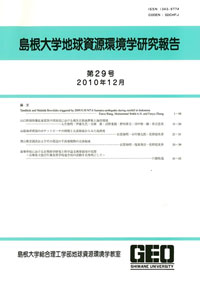島根大学総合理工学部地球資源環境学教室
ISSN:1343-9774

number of downloads : ?
Use this link to cite this item : https://ir.lib.shimane-u.ac.jp/7323
Geoscience reports of Shimane University 27
2008-12-25 発行
堆積物の元素組成からみた山陰地域神西湖の環境変化
Changes of sedimentary environments from geochemical compositions of sediments from Lake Jinzai, San’in district, Japan
Yokoi, Emi
File
Description
Changes in the sedimentary environment of Lake Jinzai were examined using the geochemical compositions of sediments. The lake has an area of 1.35 km2 and has become shallower with time. It now has a depth of about 1.5 m on average. After construction of the Sashimi River canal connecting Lake Jinzai with the Japan Sea, the lake waters have changed from fresh water to a brackish environment. The canal is a drainage system built for protection against flooding in this plain area. The lake has a varied and unique fishery, and is especially known for production of scallops(Corbicula japonica) that are renowned for their excellent taste. Geochemical examination of cored samples revealed historical changes of the environment. Total sulfur contents show a significant negative spike about 50 years before present. This change was related to large-scale flooding on the Izumo plains. Above this horizon, concentrations of P2O5 and heavy metals gradually increase upwards(e.g. P2O5, from 0.12 to 0.17 wt%: Zn, from 109 to 209 ppm). This change may be associated with increasing land use for agriculture. Th/Sc ratios and U concentrations show provenance change in accordance with this deterioration of the water environment. This change may have resulted from dominant inflow of local material of intermediate composition.
Other Article
